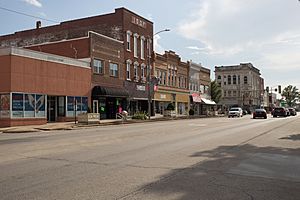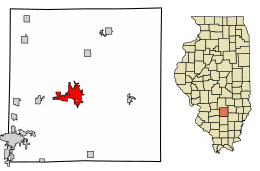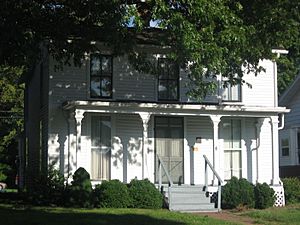Salem, Illinois facts for kids
Quick facts for kids
Salem, Illinois
|
|
|---|---|

Downtown Salem, July 2019
|
|

Location in Marion County, Illinois
|
|
| Country | United States |
| State | Illinois |
| County | Marion |
| Townships | Salem, Tonti |
| Area | |
| • Total | 7.15 sq mi (18.51 km2) |
| • Land | 6.99 sq mi (18.11 km2) |
| • Water | 0.15 sq mi (0.40 km2) |
| Elevation | 545 ft (166 m) |
| Population
(2020)
|
|
| • Total | 7,282 |
| • Density | 1,041.62/sq mi (402.18/km2) |
| Time zone | UTC-6 (CST) |
| • Summer (DST) | UTC-5 (CDT) |
| ZIP code |
62881
|
| Area code(s) | 618 |
| FIPS code | 17-67236 |
| GNIS ID | 2396526 |
| Public Transit | South Central Transit |
| Wikimedia Commons | Salem, Illinois |
Salem is a city in Illinois, United States. It is the main city, or county seat, of Marion County. In 2020, about 7,282 people lived there.
Contents
History of Salem
Salem was started in 1823. It became the main city for the new Marion County. The city is located right in the middle of the way between Indiana and Missouri. It was on an old road that is now U.S. Highway 50.
For many years, Salem had rules that limited when certain groups of people could be in town. This meant that African Americans were not allowed in Salem after the sun went down.
In the late 1930s, more oil was found and produced nearby. This caused the city's population to grow a lot.
Where is Salem Located?
Salem is in the middle of Marion County. U.S. Route 50 goes through the city center. This road is called Main Street in Salem. It leads east to Flora and west to Carlyle.
Illinois Route 37 (Broadway) crosses U.S. 50 in the city. It goes north to Alma and south to Dix. Interstate 57 is on the west side of Salem. You can get on it from Exit 116 (U.S. 50). This Interstate goes northeast to Effingham and south to Mount Vernon.
Salem covers about 7.15 square miles (18.51 square kilometers). Most of this area is land. A small part, about 0.16 square miles (0.40 square kilometers), is water. Town Creek flows through the east side of the city. It flows into Crooked Creek just south of Salem. This means Salem is part of the Kaskaskia River area.
What is the Weather Like in Salem?
| Climate data for Salem, Illinois (1991–2020 normals, extremes 1932–present) | |||||||||||||
|---|---|---|---|---|---|---|---|---|---|---|---|---|---|
| Month | Jan | Feb | Mar | Apr | May | Jun | Jul | Aug | Sep | Oct | Nov | Dec | Year |
| Record high °F (°C) | 71 (22) |
78 (26) |
85 (29) |
91 (33) |
100 (38) |
104 (40) |
105 (41) |
105 (41) |
100 (38) |
94 (34) |
82 (28) |
74 (23) |
105 (41) |
| Mean maximum °F (°C) | 61.0 (16.1) |
66.6 (19.2) |
75.3 (24.1) |
82.2 (27.9) |
88.0 (31.1) |
93.9 (34.4) |
95.4 (35.2) |
95.1 (35.1) |
91.4 (33.0) |
85.2 (29.6) |
72.9 (22.7) |
62.8 (17.1) |
97.1 (36.2) |
| Mean daily maximum °F (°C) | 38.4 (3.6) |
43.4 (6.3) |
54.0 (12.2) |
66.2 (19.0) |
75.7 (24.3) |
84.5 (29.2) |
87.8 (31.0) |
86.6 (30.3) |
80.4 (26.9) |
68.7 (20.4) |
54.3 (12.4) |
42.8 (6.0) |
65.2 (18.4) |
| Daily mean °F (°C) | 29.6 (−1.3) |
33.7 (0.9) |
43.5 (6.4) |
55.0 (12.8) |
65.2 (18.4) |
74.2 (23.4) |
77.6 (25.3) |
75.9 (24.4) |
68.6 (20.3) |
56.9 (13.8) |
44.1 (6.7) |
34.2 (1.2) |
54.9 (12.7) |
| Mean daily minimum °F (°C) | 20.8 (−6.2) |
24.0 (−4.4) |
33.0 (0.6) |
43.7 (6.5) |
54.6 (12.6) |
63.8 (17.7) |
67.4 (19.7) |
65.2 (18.4) |
56.9 (13.8) |
45.0 (7.2) |
34.0 (1.1) |
25.6 (−3.6) |
44.5 (6.9) |
| Mean minimum °F (°C) | 1.0 (−17.2) |
7.1 (−13.8) |
16.5 (−8.6) |
29.9 (−1.2) |
40.6 (4.8) |
51.9 (11.1) |
58.8 (14.9) |
56.8 (13.8) |
43.8 (6.6) |
30.8 (−0.7) |
20.1 (−6.6) |
8.2 (−13.2) |
−2.0 (−18.9) |
| Record low °F (°C) | −23 (−31) |
−23 (−31) |
−8 (−22) |
20 (−7) |
31 (−1) |
38 (3) |
48 (9) |
44 (7) |
33 (1) |
21 (−6) |
2 (−17) |
−20 (−29) |
−23 (−31) |
| Average precipitation inches (mm) | 3.07 (78) |
2.56 (65) |
3.73 (95) |
4.69 (119) |
4.99 (127) |
5.08 (129) |
4.07 (103) |
3.80 (97) |
3.54 (90) |
3.44 (87) |
3.99 (101) |
2.93 (74) |
45.89 (1,166) |
| Average snowfall inches (cm) | 3.9 (9.9) |
2.5 (6.4) |
0.2 (0.51) |
0.0 (0.0) |
0.0 (0.0) |
0.0 (0.0) |
0.0 (0.0) |
0.0 (0.0) |
0.0 (0.0) |
0.1 (0.25) |
0.6 (1.5) |
2.9 (7.4) |
10.2 (26) |
| Average precipitation days (≥ 0.01 in) | 9.5 | 8.3 | 9.8 | 10.6 | 11.8 | 10.0 | 8.5 | 8.1 | 7.1 | 8.7 | 9.3 | 9.3 | 111.0 |
| Average snowy days (≥ 0.1 in) | 2.4 | 2.0 | 0.6 | 0.0 | 0.0 | 0.0 | 0.0 | 0.0 | 0.0 | 0.0 | 0.4 | 1.6 | 7.0 |
| Source: NOAA | |||||||||||||
People Living in Salem
| Historical population | |||
|---|---|---|---|
| Census | Pop. | %± | |
| 1870 | 1,182 | — | |
| 1880 | 1,327 | 12.3% | |
| 1890 | 1,493 | 12.5% | |
| 1900 | 1,642 | 10.0% | |
| 1910 | 2,669 | 62.5% | |
| 1920 | 3,457 | 29.5% | |
| 1930 | 4,420 | 27.9% | |
| 1940 | 7,319 | 65.6% | |
| 1950 | 6,159 | −15.8% | |
| 1960 | 6,165 | 0.1% | |
| 1970 | 6,187 | 0.4% | |
| 1980 | 7,813 | 26.3% | |
| 1990 | 7,470 | −4.4% | |
| 2000 | 7,909 | 5.9% | |
| 2010 | 7,485 | −5.4% | |
| 2020 | 7,282 | −2.7% | |
| U.S. Decennial Census | |||
In 2000, there were 7,909 people living in Salem. These people lived in 3,249 homes. About 2,082 of these were families. The city had about 1,296 people per square mile.
Most people in Salem were White (97.13%). A smaller number were African American (0.72%), Native American (0.30%), or Asian (1.15%). Some people were from other groups or mixed races. About 0.72% of people were Hispanic or Latino.
About 28.6% of homes had children under 18. Almost half (48.8%) were married couples. About 11% of homes had a female head of household with no husband. About 35.9% of homes were not families.
The average home had 2.32 people. The average family had 2.91 people. The median age in Salem was 39 years old. For every 100 females, there were about 87.6 males.
The average income for a household was $34,339. For families, it was $42,070. Men earned about $31,811, while women earned about $21,931. The income per person in the city was $16,954. About 9.2% of all people lived below the poverty line. This included 13.2% of those under 18.
Schools in Salem
Salem has several public schools for students:
- Salem Community High School
- Salem Elementary School District 111, which has two schools:
- Hawthorn, for students in Kindergarten through 3rd grade.
- Franklin Park, for students in 4th through 8th grade.
- Selmaville Elementary School
Famous People from Salem
Many notable people have connections to Salem:
- Jim Bredar was a basketball player. He was born in Salem.
- Charles W. Bryan was the governor of Nebraska. He was born in Salem.
- William Jennings Bryan was a very important politician. He was a US Secretary of State and ran for president three times. He was born in Salem.
- Jim Finks was a professional football player and leader. He went to high school in Salem.
- Merle Harmon was a sports announcer. He was born in Salem.
- Bill Laswell is a musician and producer.
- Jess Marlow was a TV journalist. He was born in Salem.
- Rockette Morton was a musician. He played bass for famous bands.
- John T. Scopes was a science teacher. He was part of the famous Scopes trial.
- Morrie Steevens was a baseball pitcher for the Chicago Cubs. He was born in Salem.
- Erastus D. Telford was an Illinois state senator and lawyer.
Arts and Culture in Salem
Salem has four buildings listed on the National Register of Historic Places. These are special places because of their history. They include:
- The Charles and Naomi Bachmann House
- The Badollet House
- The William Jennings Bryan Boyhood Home
- Grace Methodist Church
In 1934, President Franklin D. Roosevelt gave a speech in Salem. He was there to dedicate a statue of William Jennings Bryan. The famous artist Gutzon Borglum made the statue. It was first in Washington, D.C., but later moved to Salem, Bryan's birthplace.
Images for kids
See also
 In Spanish: Salem (Illinois) para niños
In Spanish: Salem (Illinois) para niños





